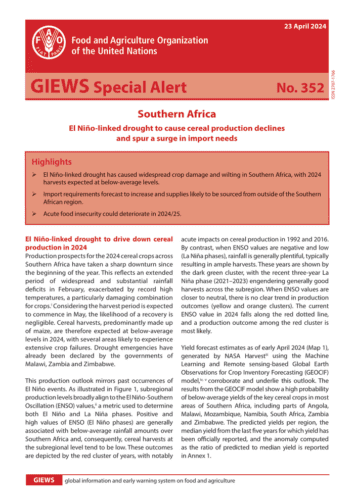Attachments
Highlights
El Niño-linked drought has caused widespread crop damage and wilting in Southern Africa, with 2024 harvests expected at below-average levels.
Import requirements forecast to increase and supplies likely to be sourced from outside of the Southern African region.
Acute food insecurity could deteriorate in 2024/25.
El Niño-linked drought to drive down cereal production in 2024
Production prospects for the 2024 cereal crops across Southern Africa have taken a sharp downturn since the beginning of the year. This reflects an extended period of widespread and substantial rainfall deficits in February, exacerbated by record high temperatures, a particularly damaging combination for crops.i Considering the harvest period is expected to commence in May, the likelihood of a recovery is negligible. Cereal harvests, predominantly made up of maize, are therefore expected at below-average levels in 2024, with several areas likely to experience extensive crop failures. Drought emergencies have already been declared by the governments of Malawi, Zambia and Zimbabwe.
This production outlook mirrors past occurrences of El Niño events. As illustrated in Figure 1, subregional production levels broadly align to the El Niño-Southern Oscillation (ENSO) values,ii a metric used to determine both El Niño and La Niña phases. Positive and high values of ENSO (El Niño phases) are generally associated with below-average rainfall amounts over Southern Africa and, consequently, cereal harvests at the subregional level tend to be low. These outcomes are depicted by the red cluster of years, with notably acute impacts on cereal production in 1992 and 2016.
By contrast, when ENSO values are negative and low (La Niña phases), rainfall is generally plentiful, typically resulting in ample harvests. These years are shown by the dark green cluster, with the recent three-year La Niña phase (2021–2023) engendering generally good harvests across the subregion. When ENSO values are closer to neutral, there is no clear trend in production outcomes (yellow and orange clusters). The current ENSO value in 2024 falls along the red dotted line, and a production outcome among the red cluster is most likely.
Yield forecast estimates as of early April 2024 (Map 1), generated by NASA Harvestiii using the Machine Learning and Remote sensing-based Global Earth Observations for Crop Inventory Forecasting (GEOCIF) model,iv, v corroborate and underlie this outlook. The results from the GEOCIF model show a high probability of below-average yields of the key cereal crops in most areas of Southern Africa, including parts of Angola, Malawi, Mozambique, Namibia, South Africa, Zambia and Zimbabwe. The predicted yields per region, the median yield from the last five years for which yield has been officially reported, and the anomaly computed as the ratio of predicted to median yield is reported in Annex 1.
Source link : https://reliefweb.int/report/mozambique/faogiews-special-alert-no-352-southern-africa-el-nino-linked-drought-cause-cereal-production-declines-and-spur-surge-import-needs-23-april-2024
Author :
Publish date : 2024-04-29 07:00:00
Copyright for syndicated content belongs to the linked Source.
